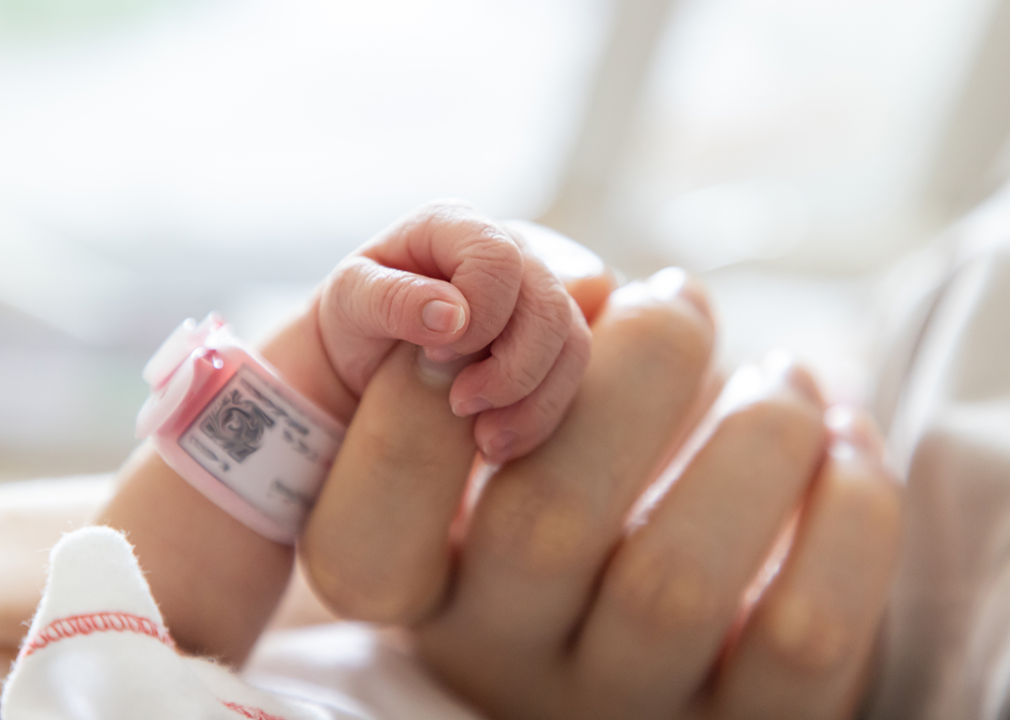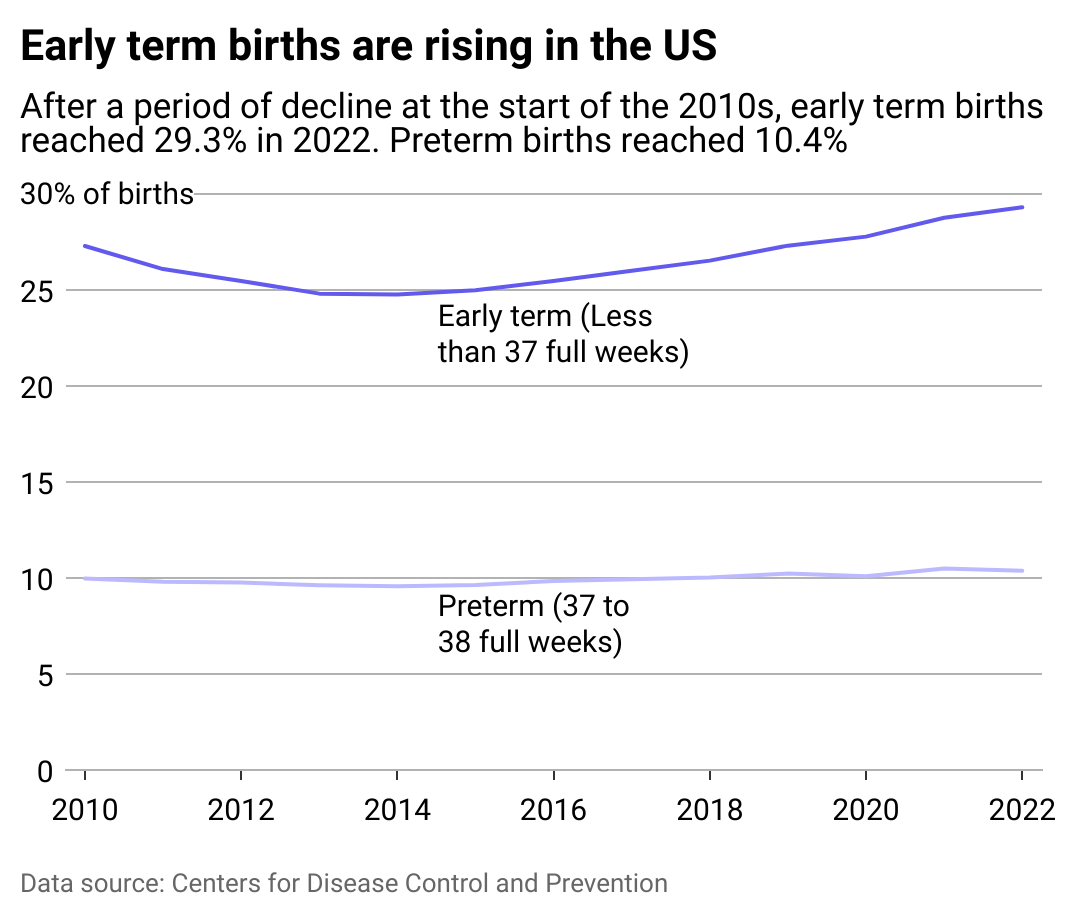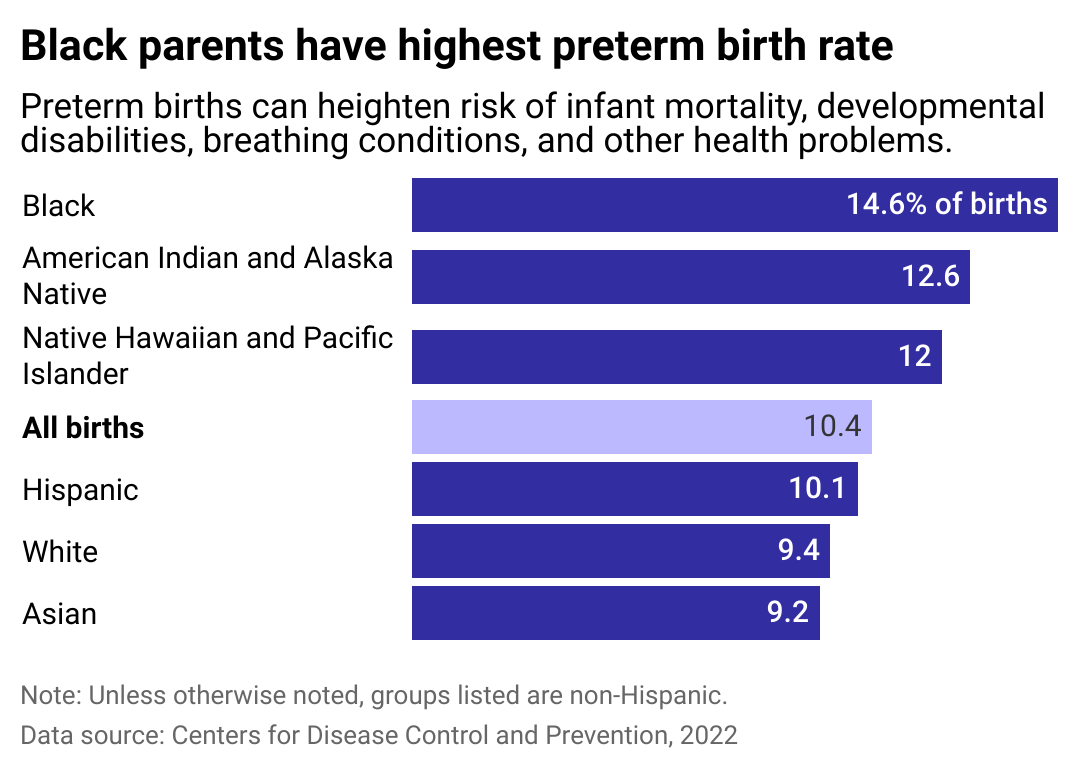The preterm birth rate is up 8% from 2014

Ratchat // Shutterstock
The preterm birth rate is up 8% from 2014
Close up preterm baby hand holding an adult’s hand.
Preterm births in the U.S. are on the rise—and experts aren’t entirely sure what’s driving the increase.
Northwell Health partnered with Stacker to explore the rising rate of preterm births in the U.S. using CDC data. In 2022, 1 in 10 babies born in the U.S. were premature, an 8% increase since 2014 after a steady decline in the early 2010s. Babies born at less than 37 weeks of gestation are considered preterm; early term births, or those between 37 and 38 in utero, increased by 20% during the same period.
There’s no one prevailing reason for the backslide in preterm births. Only 1 in 4 preterm births are medically induced, typically when a fetus is under stress due to an underlying condition. Many other established links to preterm births are already well-documented: smoking, recreational drug use, being under or over a healthy weight, and pregnancies with multiples. Although maternal age and some existing genetic conditions increase the risk of preterm births, none of these factors fully account for the startling rise.
Numerous factors may be at play, including one big one: Americans are getting sicker, according to Dr. Ellie Ragsdale, an OB-GYN-Maternal and Fetal Medicine specialist at the University Hospitals in Cleveland.
Ragsdale told CNN that increasing rates of obesity, high blood pressure, and gestational diabetes, conditions that can lead to preeclampsia and raise the risk of early delivery, are all contributing factors.
Babies born before reaching full-term tend to have lower birth rates and are at increased risk of health problems without the final weeks to develop their brain, lungs, and liver. In the short term, premature babies tend to remain in the hospital longer and may struggle with stomach and respiratory conditions. They’re also more vulnerable to infections. Over the long term, they may experience developmental delays, chronic disorders like cerebral palsy, asthma, hearing loss, and issues with their heart, stomach, kidneys, teeth, and hormonal systems.
Many other, less direct factors that lead to preterm births result from the complex American makeup of social, economic, and environmental conditions. There are psychosocial factors, such as the impact of the pandemic and delayed access to health care. Environmental factors, like air pollution, also come into play; observational data published in the February 2024 issue of The Lancet Planetary Health journal links chemicals found in plastics to tens of thousands of preterm births in the U.S.
Estimates from the CDC show that of the nearly 20,000 infants that died in the U.S. in 2020, preterm birth and low birth weight were the second-leading causes of mortality. However, physicians believe that around half of preterm births in the U.S. are preventable, given that women with limited or no treatment for existing medical conditions and who lack access to maternal care services—which are more restricted in states with anti-abortion laws—are contributing to premature births.
A lack of access to insurance and, by extension, health care is also a factor. The most recent Census data shows that over 1 in 10 working-age Americans were uninsured in 2021. In Florida, where 1 in 6 women of childbearing age were uninsured in the same year, just over half of infants are born to women receiving adequate prenatal care, according to a March of Dimes analysis of Census data.
Editor’s note: While this story centers on pregnancy and birth and uses gendered language in some cases when referring to data, we acknowledge that not all people who can become pregnant identify as women or mothers.
![]()

Northwell Health
A decade of preterm births
Line chart showing early term births are rising in the U.S. After a period of decline at the start of the 2010s, early term births reached 29.3% in 2022. Preterm births reached 10.4%.
“Early term” births between 37 to 38 complete weeks can slightly increase the chances of neurodevelopmental challenges; however, “preterm” babies are at the most significant risk of disease and early death, most born between 32 and 37 complete weeks of pregnancy, according to the World Health Organization.

Northwell Health
Racial and demographic disparities remain
Bar chart showing Black parents have highest preterm birth rate. Preterm births can heighten risk of infant mortality, developmental disabilities, breathing conditions, and other health problems.
Black and Native people are disproportionately at higher risk of delivering prematurely. The racial disparities are so vast that, on average, a white woman would have to smoke up to nine cigarettes daily before and after pregnancy to match the premature delivery rates of Black women, according to a cross-sectional study of 25 million pregnant women in the U.S. published in 2019 in the JAMA Network Open journal.
At the root of the ongoing racial disparity in preterm births is systemic racism that manifests in pervasive stress, increased exposure to toxins, and a lack of socioeconomic opportunity, according to a 2021 article in the journal Frontiers. Tamara Etienne, a third-grade teacher in Florida, told KFF Health News that the stress of prolonged racism became more profound during pregnancy.
“I’m experiencing it every day, not walking alone, walking with someone I have to protect,” she said, describing her cortisol levels as “immeasurable.” Studies, including a 2022 paper published in the BMC Pregnancy and Childbirth journal, have shown a link between cortisol levels and a greater risk for preterm labor.
Black women are also disproportionately diagnosed with hypertension as compared to white women. Like diabetes and high blood pressure, it can increase the risk of preterm deliveries. Mortality rates among Black mothers are also higher, and they are more likely to face obstacles to care. Black women are more likely to report being treated unfairly based on their race, and have been disproportionately affected by hospital closures, particularly in rural areas.
Sometimes, the manifestations are subtle or indirect. A 2018 study in the Journal of Computers in Human Behavior found that mothers were 16% more likely to give birth prematurely if they resided in states that had the most negative comments towards Black people on Twitter. But the domino effect of racism, stress, high blood pressure, and inflammation that can potentially impact the fetus’s growth or trigger premature labor is impossible to ignore.
In comparison to other developed countries, U.S. rankings for maternal and infant health outcomes are grim. With nearly unchanging preterm birth rates over a decade, the World Health Organization has updated global guidelines designed to save the lives of more mothers and newborns. Members of the United Nations have also agreed to work towards Sustainable Development Goals that aim to reduce newborn mortality by 2030 significantly.
Ensuring pregnancies reach full-term improves the likelihood that children will live longer, healthier lives.
Story editing by Alizah Salario. Copy editing by Kristen Wegrzyn.
This story originally appeared on Northwell Health and was produced and
distributed in partnership with Stacker Studio.